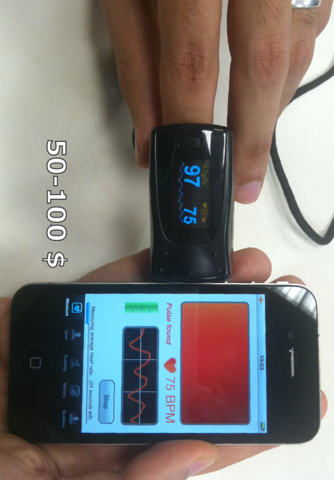
Heart Fitness app for iPhone and iPad
Developer: Senscare
First release : 22 Oct 2010
App size: 2.65 Mb
Measure your heart rate with the built-in camera and monitor your physical fitness using our patented technology. Developed in the laboratory of Centre Hospitalier Universitaire in France, this method has been tested and validated against FDA-approved instruments in clinical conditions.
Best results for iPhone 4G, works on 3GS.
Whether youre a marathon runner or a couch potato (sedentary), you probably have some idea of how fit you are. But having more than a general sense of your fitness level can help you set fitness goals, monitor how youre doing and maintain your motivation.
This application offers an easy way to measure your heart fitness—one of the most important indicators of your overall physical health.
Heart fitness is a prime bulwark against myriad medical problems, including but not limited to the No. 1 killer in the United States, heart disease; more than 70 million Americans suffer from some form of it.
This test really couldnt be easier: all you need is to cover iPhone camera with your fingertip and proceed to 30s physiological measurement. During measurement the instantaneous heart rate is monitored in beats per minute (BPM) and the physiological plethysmographic signal is also displayed.
Make sure that finger detection gauge is green and full before and while you are making measurement, and that you are in sitting position for 5 min at least.
A low heart rate at rest suggests that your body is physically fit—a key element of a healthy body—so the lower the figure, the greater your cardio fitness. (Source: American heart association). Once you have the number of beats per minute, its easy to gauge your situation and to compare it with friends.
Don’t despair over an unsatisfactory result, however: Your level of cardio fitness can improve remarkably quickly, with as little as 20 minutes of physical exercise four to five times a week.
The American College of Sports Medicine recommends that you assess four crucial components of physical fitness before you start a regular program of exercise. These include aerobic fitness, maximum and reserve heart rate. Set aside some time to calculate your Training Chart. Once you know where youre starting from, you can plan where you want to go.
Keeping track of your progress is an excellent way to maintain your motivation. Assess your fitness level 2 weeks after your initial measurement and every three to weeks afterward.
Repeat your assessment a year after your first measurement to see how far youve come. Celebrate your progress and set new goals.



